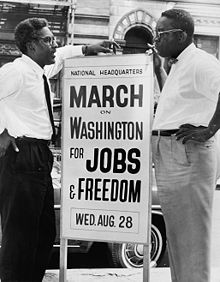The March on Washington for Jobs and Freedom is probably best remembered today for Martin Luther King, Jr’s march address, “I Have A Dream.” That speech, along with dramatic media accounts of black struggle inspired a generation to take action, including LGBT activists, feminists, immigration reform advocates, and anti-imperialists, each of whom would also make their mark on society.
But, 50 years later, the economic demands of the marchers, including for decent housing, educational equity and school integration, full employment, and a livable national minimum wage, remain little more than dreams. Meanwhile, a growing percentage of whites believe that racism is a thing of the past, with the obvious though usually silent partner of that sentiment being the belief that people of color who complain of racism are simply manipulating historical wrongs long since corrected in order to leverage unfair advantages.
The reality, though, is that we have a long way to go to end racial inequality.
Median white wealth is about eight times that of blacks, largely as the legacy of pre-civil rights exclusion of black people from economic opportunity, including post-depression economic stimulus programs like the GI Bill that helped build the American middle class. Because the wealth of one’s parents is among the most reliable indicators of one’s future financial success, regardless of race, that wealth gap means that black children inherit a profound disadvantage. The playing field is by no means level.
Meanwhile, black unemployment in the U.S. has held steady at about twice that of whites for the last 40 years, contributing to that unfair inheritance.
Tilting the playing field further is the fact that those who grow up in neighborhoods with high concentrations of poverty are much more likely to remain poor, again, regardless of race. But, the combination of racial wealth and employment gaps and segregation dictates that this condition is more likely to be experienced by blacks and Latinos.
School segregation also perpetuates racial inequity because black majority schools have significantly fewer resources. In 2010, 74.1 percent of black students attended majority black schools compared with 76.6 percent who did so in 1965.
Racial profiling and police harassment in communities like New York City plague black communities. In 2011, in spite of the fact that whites are more likely to have drugs and guns when stopped, New York cops conducted more stops of black men than there were black men in New York that year.
What happened to stall the dream?
The answer, at least in part, is white resistance expressed in two ways.
First, as long as the Civil Rights Movement was able to present black people as innocent victims of overt, often violent, racism, white support grew, especially in the North where whites were quick to distinguish themselves from their supposedly backward Southern brethren. In fact, in 1965, 71% of respondents to a national poll said the Johnson administration was moving at just the right speed or not fast enough to protect civil rights for black people.
But once images of black urban uprisings in Northern cities hit the media, support, especially among Northern whites, collapsed, indicated by a 1967 poll that had 52% of all Americans saying the civil rights agenda was rolling out too quickly. A critical portion of white support was based on an all or nothing proposition. Either blacks were innocent victims whose freedom agenda was perceived as harmless to their interests, even contingent on their largesse, or they were potential perpetrators prone to criminality and violence, a sentiment that made the uprisings into an opening for civil rights opponents who responded with racially coded “tough on crime” messaging that eventually led to the war on drugs.
Second, as long as the Civil Rights Movement was mainly understood in terms of soaring rhetoric and inspiring accounts of black courage and suffering, many were on board. But, once the Civil Rights Movement started to use its power to exceed liberal white largesse and demand affirmative action, fair housing, and school integration programs like busing, white sentiment turned.
Advancing racial justice in the next 50 years will require a two-pronged strategy for a two sided problem. First, we need to draw the connection between structural racial disadvantage built into our economic and political systems, and the lack of real democratic accountability and economic opportunity suffered by most of us, regardless of race, especially as ever more are feeling marginalized by the 1%.
Second, we need to bring unconscious racism into the realm of consciousness. Unconscious racist attitudes are the new racial codes. These attitudes cause us to accept racial inequities as products of weaknesses of character rather than as the result of structural disadvantage, and all while we pride ourselves in living like Martin and judging people not “by the color of their skin, but by the content of their character.”

One reply on “Still Dreaming About Jobs and Freedom”
Finding the root of why racists believe like they do took me awhile. My school teachers and parents never explained this entrenched and all-too-common belief system in the U.S.
It takes three ingredients to make a racist.
1. Belief in biological race
2. Ignorance, or disbelief in the idea that race is also a social and demographic construct.
3. Scarcity mentality – the belief that one must eliminate the competition to reserve enough for ones own tribe.